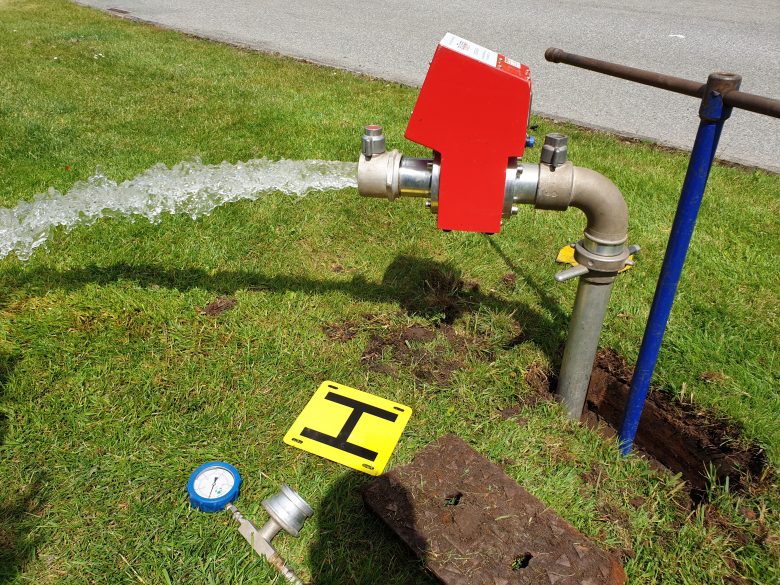Fire Hydrant Problems
It is important for property owners to be aware of the hydrants on or near their property and to know what they can do about any fire hydrant problems they discover. These include:
1. Missing, damaged or covered fire hydrant marker plates
If it is a privately owned fire hydrant then missing or damaged hydrant marker plates can usually be fixed by us. If it is not privately owned ie it is a statutory fire Hydrant, then these are owned by the water companies. Local Authority Fire and Rescue Services are usually responsible for the maintenance of hydrant signage that you see above ground. White or grey posts with a blue identification plate are the responsibility of the Water Company.
Hydrant marker plates are rectangular usually yellow signs, with a large black H and a pair of numbers, usually attached to a wall, lamp post or a short concrete post. If owned by the water company the signage is white / blue. The two numbers on the plate show the size of the water main and the approximate distance of the hydrant from the plate.
Fire services do not have to rely solely on the marker plates. All hydrants are also shown on the digital maps available in fire engines, so that the nearest one can be identified while firefighters are on their way to an incident. This enable the firefighters to find the hydrant even if marker plates are missing or broken. Once reported hydrant signs will be repaired in due course.
If the marker plate is covered by overgrown grass or plants, local residents or property owners can help by cutting back any undergrowth that are covering the hydrant post.
2. Dangerous, missing or cracked hydrant covers and frames
When a fire hydrant cover is missing or cracked, it can expose the hydrant to the elements, which can cause it to freeze and get blocked with mud or silt. This can stop it working when firefighters need it.
Privately owned hydrants should be tested and maintained and be kept in good working order by the responsible person(s). If you are responsible for private fire hydrants and see dangerous, missing or cracked hydrant covers or frames then get in touch using the details below we can help with regular testing, maintenance and repairs for all fire hydrants.
Statutory fire hydrants are owned, installed and maintained by the water companies to provide water for the Local Authority Fire and Rescue Services. Dangerous, missing or cracked hydrant covers and frames should be reported to the Local Authority Fire and Rescue Service.
3. Leaks from fire hydrants
Most leaks are below ground and not visible, but even leaks on the surface are often not reported due to people assuming someone else will have already reported a problem. Leaks affect water flow and pressure from a fire hydrant, making it less effective if firefighters need to use it. Report any leaks as soon as they are discovered either to the responsible person for a privately owned fire hydrant or to the Local Authority Fire and Rescue Service. Fire Hydrants Direct are on call to repair and test privately owned fire hydrants.
4. Leaks from water supply pipes or mains
Leaks from water supply pipes or mains are the responsibility of the water company but can affect the availability of water from a fire hydrant. The sooner leaks are reported to the water company, the sooner they can fix the problem.
5. Illegal use of fire hydrants
Many problems with fire hydrants are caused by illegal use. It is illegal to use a fire hydrant to obtain water for purposes other than firefighting “unless authorised by the water authority or another person to whom the hydrant belongs” (source: Fire and Rescue Services Act 2004, section 42, subsection 6).
The public can tell the local water companies or the fire service when they suspect illegal use. Key pieces of information such as the registration number and any company names on a vehicle, along with the date, time and location of the activity will be very helpful, but please avoid confrontation with suspected offenders.
6. Parking on or preventing access to a fire hydrant
It is an offence to be parked over or to prevent access to a fire hydrant when it is required for firefighting (source: Fire and Rescue Services Act 2004, section 42, subsection 7). Parking for a short time on a hydrant can occur occasionally, but if this happens repeatedly with the same vehicle it should be reported to the Local Authority Fire and Rescue Service.
Be considerate when parking near a fire hydrant marker post and ask friends, relatives and neighbours to be aware, as this could save time in an emergency.
We are a team of specialists with many years of practical experience in fire hydrants. To find out more browse our site or if you require installation, testing or servicing of privately owned fire hydrants get in touch for a chat.





